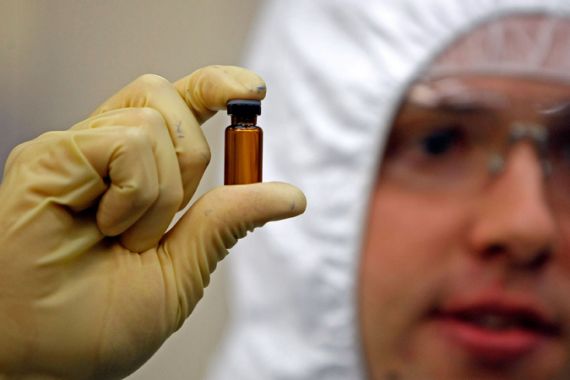Hooked on drugs, medical world needs change
Although resistant bacteria and viruses may be killed by innovative methods, the focus remains on pharmaceuticals.

 | |
|
A day before the release of the Journal of the American Medical Association’s April 13 issue, which addresses an expansive array of diseases and medical and biological immunity, top dogs from the medical community gathered to share their endeavours at combating the global proliferation of various diseases.
Christian Liendhart, a senior scientific adviser at the World Health Organisation, presented the findings of a study conducted across 11 sites in Africa, Asia and Latin America on the efficacy and safety of a four-drug fixed-dose combination (FDC) treatment, use of which could potentially lower the risk of patients developing and disseminating drug-resistant bacteria.
Keep reading
list of 4 itemsDeadly Sahel heatwave caused by ‘human-induced’ climate change: Study
Woman, seeking loan, wheels corpse into Brazilian bank
UK set to ban tobacco sales for a ‘smoke-free’ generation. Will it work?
“It is essential that FDCs are made available worldwide,” Liendhardt said at the National Press Club on Tuesday. “While new regimens of drugs are being developed for the treatment of tuberculosis, it is essential that strategies are developed for their introduction in national TB control programmes.”
However, some say pouring resources into such stopgap solutions reveals a kind of desperation in the established medical community to hold onto a paradigm that many scientists say is deeply flawed.
“What the mainstream medical community is calling XDRTB – Extensively Drug-Resistant Tuberculosis – is a problem that places like the Gates Foundation is putting a lot of money into, but only for fairly conventional treatments,” said Stephen Buhner, a medical author and researcher at the New Mexico-based Foundation for Gaian Studies.
“The focus on combination therapy basically mimics plant medicines, which have several hundred constituents in them and are often more effective for resistant organisms than a pharmaceutical might be,” he added.
“Given the dynamics of the way technological societies are set up, money will continue to be misspent in protecting the old paradigm – but in my perspective, they are not exactly addressing the real problem. The medical establishment believes it can exterminate all disease organisms by using pharmaceuticals, an assumption that has been proved false, because the initial assumptions about the nature of bacteria were just wrong,” he concluded.
Buhner is certainly not alone in his prognosis that radical change is required.
“About two months ago we published a commentary by Dr James Hughes from the Centres for Disease Control, in which he pointed out the lack of research and development for new antimicrobial agents,” said Phil Fontanarosa, the executive editor of JAMA.
“If the ten-year timeline on antibiotic effectiveness is true, coupled with the absence of a total freeze on new drugs to deal with the resistant strains that are absolutely inevitable, we all could be facing real challenges in dealing with both bacterial and viral infections,” he added.
Some believe that even JAMA’s modest attempts at addressing increasingly solid evidence of an imminent medical catastrophe are largely inadequate.
“There’s a big difference between science and politics,” said Buhner.
“If you look at the majority of newspaper articles – or even television reports – about infectious diseases, bacteria and microbial resistance, they will invariably discuss the horrors of an outbreak and follow it up with the assurance that officials have it under control,” he added, stressing that JAMA stays true to a well established media and political culture that posits the current medical paradigm as something that can be reformed.
Camille Sabella, an associate professor of pediatrics at the Cleveland Clinic Lerner College of Medicine, discussed the downward spiralling conditions of safe-havens-turned-breeding grounds.
According to Sabella, 5.6 per cent of hospital patients in the US contract some form of health care-associated infections, which account for 1.7 million preventable infections annually and results in over 99,000 deaths each year.
This hospital-born outbreak also ratchets up a thumping bill of 28-33 billion dollars annually, hijacking much-needed resources that could instead be funnelled into research or providing better primary healthcare.
Sabella, whose study on the differences between adult and paediatric patients regarding the appropriate treatment of HAIs also appears in JAMA’s April 13 issue, stressed at the press briefing that immunocompromised children, such as cancer patients, premature babies and transplant patients in hospitals are particularly vulnerable to the horrors of HAIs.
Along with his co-author Charles Foster, Sabella’s commentary says “precise definitions need to be established [and] rigorous research needs to be performed… the expectation that adult criteria can be used to define, track and eliminate HAI in children is problematic”.
Echoing those sentiments across the hallway of the National Press Club, HHS Secretary Kathleen Sebelius was joined by leaders of major hospitals, physicians, nurses and patient advocates when she announced the Partnerships for Patients initiative which hopes to avoid 60,000 deaths caused by preventable hospital injuries and complications, as well as save up to 35 billion US dollars, including 10 billion US dollars in Medicare.
With over 500 hospitals, along with scores of medical practitioners and employers across the country already committed to the initiative, 500 million dollars have already been made available through the Community-based Care Transitions Program and 500 million more will be dedicated from the Centres for Medicare and Medicaid Services.
A version of this article first appeared on the Inter Press Service news agency.